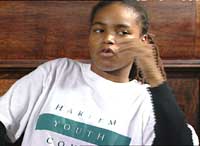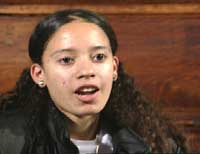|
|
| Making Things Right The Youth Court of Harlem
Madamaache has had plenty of arguments in her 17 years, and
she is ready to argue again now. A boy of 11 has been suspended from
school for making a lewd gesture at a teacher, and she thinks the
whole affair has been trumped up by kids who don’t like him.
“Today’s case is supposed to be a serious case, but
in fact it is nothing but a lie,” she declares. “The teacher
heard hearsay from students, and I’m going to give you a little
outline about how it went. The kids told the teacher; the teacher
told the principal; and the principal gave my client a suspension.
I ask that you listen to this case clearly and understand that my
client is innocent.”
Six jurors in Harlem Youth Court t-shirts listen with the cautious
air of people who know their hearsay from their hard facts. For
months, these teenagers have been practicing their roles twice weekly
after school, learning the workings of the justice system and meting
out sentences to young offenders.
In the process, said their mentor Jabari Osaze, they acquire valuable
skills in critical thinking, active listening, consensus building,
and public speaking. They learn how neutral language can de-escalate
potentially volatile situations. And they gain a new understanding
of balancing rights and responsibilities in an environment where
youth voices rarely matter to adults. [For
an interview with Jabari Osaze, click here.]
Trying to draw the youngster out, the jurors ask questions of
the respondent, frustrated at times because his responses, some
barely audible, shed litle light on the matter at hand:
“I thought the sentence was fair,” says Dena, the eighth-grade
presiding judge in the proceedings, when the group gathers for a
debriefing and critique after the case is closed. “The jury
didn’t like his attitude, but he wasn’t here for that.
He was here for harassing the teacher.”
Jabari Osaze, who has constantly mentored the court’s proceedings,
warmly offers both support for each student’s work and critical
feedback. “Judge, I’m getting much more comfortable with
the way you run the room,” he says. “I think you organize
the room very well. You feel comfortable asking people to speak
up, you feel comfortable ad libbing in some cases! You’re doing
a very good job of using what you know the authority of the judge
is." He continues in a more critical vein. "A few times
you were a little bit harsher on the youth respondent than you should
have been. But it’s important that you make sure we can hear
what he says.”
Helping Offenders Re-Connect
An initiative of the Harlem Center for Court Innovation, the Harlem
Youth Court is just one of some 800 youth courts across the nation.
Local programs vary considerably; some work with adult judges, for
example, others with youth judges. In
Alaska, teen courts actually determine
determine innocence or guilt.
But most, like the Harlem Youth Court, review acknowledged
offenses to decide on appropriate sentences.
These programs illustrate well the differences between Youth Court
and adult court. Youth Court jurors are able to question a respondent
directly, to expand their understanding of the offender, his or
her motivation, and the circumstances of the misdeed. Soliciting
such information, as today’s Harlem case shows, is often a
challenge when jurors encounter a reticent or nervous respondent.
Despite this difficulty, the approach has its advantages.
“In
adult court, it’s like both sides [are] working against each
other,” explains Juston, 17, a Harlem court member. “But
in youth court we work with each other. The community advocate and
the youth advocate and the jury, we’re all here for one purpose,
to help the youth respondent be responsible for what he or she has
done.”
Indeed, a growing trend in many youth courts seeks not just to
dole out punishment but to help restore young transgressors to a
productive role in their community. This emphasis on “restorative
justice” focuses less on testimony, procedure, and evidence
and more on dialogue and understanding. While taking into account
the crime's impact on the victim, this approach also acknowledges
that the offense has harmed the entire community—and attempts
to right the balance, bringing the offender into a more healthy
balance with those around him.
Assigning young offenders to participate as court members is a
common tactic. Peter,
an 18-year-old from Cedar Rapids, Iowa, recalled such a sentence
in a shoplifting case he helped prosecute in the Peer Review Court
of Linn County. During the trial the offender seemed “not to
be repentant at all,” he said, but the sentence required her
to participate as a juror in at least two youth courts, in addition
to her probation or community service. “She went above and
beyond that call, and actually became a volunteer. She started going
to school more, she stopped hanging around with her old friends,
and her life really turned around.”
Another
successful strategy of youth courts around the country is the use
of mediation—both in training for court members and in sentencing
offenders. Oregon teens involved with the Stayton Sublimity Youth
Court, for example, receive training in mediation from third-year
law students
at Willamette University. “It’s a good way to get
problems solved,” said Kirsten, a Stayton participant attending
a national conference of youth courts last year. Mediation also
serves as an effective tool for bringing offenders into productive
dialogue with their victims—and importantly with their parents.
“One kid stole some items from Buy-Mart, and there wasn’t
much trust between him and his parents," Kirten recalled, "so
part of the sentence was to go through mediation. He had to give
an in-court apology to his mom, and they hugged and were both crying.”
Changing Attitudes and Habits
Youth court members recognize and appreciate their power to help
turn around their peers' lives. It is for this reason that Peter,
the Oregon participant, most enjoys the defense attorney's role.
"You get to know the person better," he said. "You
get that hands-on feeling that you're really changing someone's
life, helping them take a step in the right direction."
But Youth Court aims to help its volunteers as well as the offenders.
Many of these young court members freely admit that they themselves
have committed the same offenses for which they are now sentencing
their peers. But after a time, Osaze said, the typical Harlem Youth
Court member “is truant less, acts more appropriately in public,
does not hop the turnstile." As they grow increasingly aware
that actions have consequences, Osaze continued, "they begin
to look at their options differently. They really do learn from
each other.”
And they see how they themselves are changing. Madama says she
has learned to act differently when conflicts arise within Harlem's
close-knit team. “When we have problems, some of us take the
leadership role and just say 'listen, let’s do this and not
have it escalate to a fight.'”
The ability to use this neutral language, Osaze continued, "is
probably the skill that, when they really begin to understand, they
use more than others in other environments. A neutral language speaker
is a speaker that can be effective in business, in college, in academia—almost
anywhere."
That these young people’s career aspirations have also changed
after the Youth Court experience seems to indicate that they get
his point. “We actually play out the roles that are real live
things that you can be when you grow older,” says Yohany, 17,
who now hopes for a career in law enforcement. “If I can do
this here I can take it to another level.”
Dena, the 14-year-old judge, bluntly agrees. “In school,
I don’t have control. They don’t have to listen to nothing
I say,”
she says. “Here, you have to listen
to me. I want to be a lawyer when I grow up.”
Youth Court Extensions
More about the Harlem Youth Court
A WKCD interview with mentor Jabari Osaze
Hear audio clips of Harlem Youth
Court members
Resources and information on youth
courts nationwide
Read more of this WKCD feature story, "Making Peace, Restoring
Justice"
|
 In another life, Madama concedes later, her opinions might have
erupted into a shouting match spiced with the street language of
her Harlem neighborhood. But on this autumn Thursday afternoon,
she stands instead before a black-robed Dena, 14, and uses the language
of the court to take the young boy’s side.
In another life, Madama concedes later, her opinions might have
erupted into a shouting match spiced with the street language of
her Harlem neighborhood. But on this autumn Thursday afternoon,
she stands instead before a black-robed Dena, 14, and uses the language
of the court to take the young boy’s side.

 Youth
Court sentences always entail community service; sometimes respondents
must also write essays, offer apologies, or make restitution for the
damage they have done.
Youth
Court sentences always entail community service; sometimes respondents
must also write essays, offer apologies, or make restitution for the
damage they have done.
 Imposing a sentence of community service, for example, youth court
jurors often consider how the offender’s strengths could benefit
the community as well as how the service might help the offender
along a new path. The youngster sentenced to work in the Harlem
Art Park will come into frequent contact with the Youth Court team
that operates from the courthouse next door. “This is a young
person that just moved to a new school, and he’s a little bit
uncomfortable there,” Jabari Osaze noted. “Perhaps being
with some people who can be supportive and positive will help him.
We’ll even see whether he’s interested in doing Youth
Court himself.”
Imposing a sentence of community service, for example, youth court
jurors often consider how the offender’s strengths could benefit
the community as well as how the service might help the offender
along a new path. The youngster sentenced to work in the Harlem
Art Park will come into frequent contact with the Youth Court team
that operates from the courthouse next door. “This is a young
person that just moved to a new school, and he’s a little bit
uncomfortable there,” Jabari Osaze noted. “Perhaps being
with some people who can be supportive and positive will help him.
We’ll even see whether he’s interested in doing Youth
Court himself.”
 Adults mentors like Osaze play a large part in that process—which
is no simple task. “One of the most difficult things in Youth
Court training,” he explained, “is trying to teach young
people to disagree without being disagreeable. Adults have difficulty
with that, and because I believe young people are a lot more honest
than adults are, they have even more difficulty. Honesty doesn’t
necessarily have to be rudeness, though, and that’s one of
the things that we work with them on.”
Adults mentors like Osaze play a large part in that process—which
is no simple task. “One of the most difficult things in Youth
Court training,” he explained, “is trying to teach young
people to disagree without being disagreeable. Adults have difficulty
with that, and because I believe young people are a lot more honest
than adults are, they have even more difficulty. Honesty doesn’t
necessarily have to be rudeness, though, and that’s one of
the things that we work with them on.”